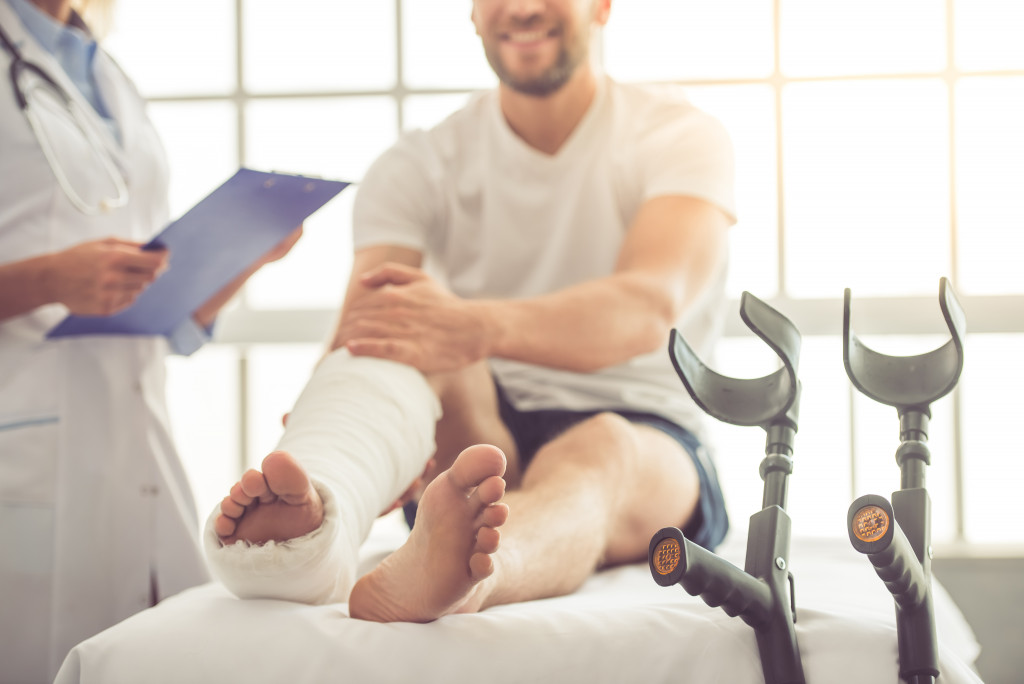- Seek immediate medical attention after sustaining a leg fracture.
- Follow the RICE method (Rest, Ice, Compression, and Elevation) for optimal healing.
- Take prescribed pain medication as directed and explore non-prescription alternatives.
- Utilize assistive devices to reduce pressure on the fractured leg and move safely.
- Visit a reliable orthopedic surgeon for the best treatment of leg fractures.
Dealing with a leg fracture can be a challenging and painful experience. Whether it’s a simple fracture or a complex break, taking the right steps for proper healing and recovery is crucial. This guide provides five essential tips to help you effectively manage a leg fracture and promote a speedy recovery.
1. Seek Immediate Medical Attention
The first and most crucial step after sustaining a leg fracture is to seek immediate medical attention. Do not delay visiting a reliable orthopedic doctor or the nearest emergency department. A professional evaluation is essential to determine the severity and type of fracture and establish an appropriate treatment plan. Follow the doctor’s instructions regarding immobilization, pain management, and further diagnostic tests like X-rays or CT scans.
2. Follow the RICE Method

After receiving medical treatment, following the RICE method, which stands for Rest, Ice, Compression, and Elevation, is essential. Rest your injured leg and avoid weighting it to prevent further damage. Apply ice packs wrapped in a cloth or towel to the affected area for 15-20 minutes every two to three hours to reduce swelling and pain. Compression can be achieved by wrapping an elastic bandage around the fractured leg, ensuring it is not too tight to impede circulation. Lastly, elevate your leg by propping it up with pillows or cushions above the level of your heart to minimize swelling.
3. Adhere to Medication and Pain Management
Pain is often an inevitable part of a leg fracture. Your doctor may prescribe pain medication to help alleviate discomfort during healing. It is crucial to take the medication as prescribed and follow the recommended dosage. Consult your doctor immediately if you experience any side effects or have concerns.
Benefits of Taking Prescription Medication
Taking your prescribed medication can help reduce discomfort and promote healing. Your doctor will be able to determine the best course of treatment for you depending on the severity of your leg fracture. Discuss any potential side effects with your doctor before taking a prescription pain reliever. Regularly taking medication as prescribed can help keep your symptoms under control, leading to faster recovery times.
Monitoring Pain Levels
It’s important to know how much pain relief you need at various times throughout the day and night. Keep track of when you take medications, their dosage, and their effectiveness in managing your pain levels. This info may allow you and your doctor to adjust the dosage or type of medication as needed.
Non-Prescription Alternatives
In addition to prescription medication, non-prescription alternatives such as ibuprofen, acetaminophen, or topical pain relievers may also be beneficial in managing your pain levels. However, always consult with your doctor before taking any over-the-counter medications. Additionally, there are other holistic remedies that you can explore that may provide additional relief. These include massage therapy, biofeedback, acupuncture, and meditation.
Maintaining Proper Hygiene and Care
Keeping your fracture site clean is essential to reduce the risk of infection while it heals. Wash the area gently with soap and warm water. Applying an antibiotic ointment can also help protect the wound. Follow your doctor’s instructions for proper bandaging to avoid further swelling or discomfort. Limiting movement of the affected area during recovery can also help ensure a speedy healing process.
4. Utilize Assistive Devices
During your recovery period, your orthopedic doctor may recommend using assistive devices such as crutches, walkers, or wheelchairs. These devices aid in reducing pressure on the fractured leg, promoting healing, and preventing further injury. It is vital to use the recommended assistive device correctly and follow the instructions provided by your doctor or physical therapist. They can guide you on proper techniques for walking, climbing stairs and getting in and out of bed or chairs safely.
5. Visit A Reliable Orthopedic Surgeon

It is important to visit a reliable orthopedic surgeon to properly treat and manage leg fractures. An experienced orthopedic doctor can provide an accurate diagnosis, develop a personalized treatment plan, and offer guidance on making the best out of your recovery process. Surgery may be necessary in cases of severe fractures or complex breaks to properly repair the injured leg.
In Summary
Dealing with a leg fracture can be a challenging and painful experience, but by following these five tips, you can effectively manage your injury and promote a faster recovery. Remember to seek immediate medical attention, adhere to the RICE method, follow your doctor’s instructions regarding pain management, utilize assistive devices as recommended, and embrace physical therapy and rehabilitation. Your reliable orthopedic doctor will guide you through the recovery process, providing personalized care to ensure optimal healing and restoration of leg function. Stay positive, patient, and committed to your recovery journey, and you will soon be back on your feet again.
